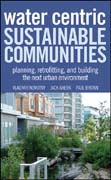
Water centric sustainable communities: planning, retrofitting and building the next urban environment
Novotny, Vladimir
Ahern, Jack
Brown, Paul
The current literature compartmentalizes the complex issue of water and wastewater into its discrete components; technology, planning, policy, construction, economics, etc. Considered from the perspective of sustainability, however, water in the urban environment must be approached as a single resource that can be continuously reused and recycled. This book will be the first to capture all of the current work on this idea in a single, integrated, plan for designing the water-centric cities of the future. From new construction to the retrofitting of existing systems, this book presents the case for a new urban relationship to water, one with a more sustainable connection to the environment andthe hydrological cycle. Through case studies of successfully planned and built systems around the world, the book will educate the reader about the need for a new approach to urban water management, and make the case that these changes are not only possible but imperative INDICE: CHAPTER I Historic Paradigms of Urban Water/Stormwater//WastewaterManagement and Drivers for Change. I.1 Introduction. I.2 Historic Paradigms -From Ancient Cities to 20th Century. I.3 Drivers for Change towards Sustainability. I.4 21st Century and Beyond. REFERENCES. CHAPTER II Urban Sustainability Concepts. II.1 Vision of Sustainability. II.2 Sustainability Concept and Definitions. II.3 Towards the Fifth Paradigm of Sustainability. II.4 Cities of the Future - Water Centric Ecocities. II.5 Ecocity/ecovillage concepts. REFERENCES. CHAPTER III Planning and Design for Sustainable and Resilient Cities: Theories, Strategies and Best Practices for Green Infrastructure. III.1 Introduction. III.2 Ecosystem Services. III.3 Planning for Resilient and Sustainable Cities. III.4 Best Practices for Green Infrastructure. III.V Discussion. References. CHAPTER IV Stormwater Pollution Abatement and Flood Control - Stormwater as a Resource. IV.1 Urban Stormwater - Problem or an Asset. IV.2. Best Management Practices to Control Urban Runoff for Reuse. IV.3 LID Urban Drainage- a Step to the Cities of the Future. References. V. Water Demand and Conservation. V.1 Water Use. V.2 Water Conservation. V.3 Substitute and Supplemental Water Sources. References. CHAPTER VI Water Reclamation and Reuse. VI.1 Introduction. VI.2 Water Reclamation and Reuse. VI.3 Water Quality Goals and Limits for Selecting Technologies. References. CHAPTER VII Treatment and Resource Recovery Unit Processes. VII. 1 Brief Description of Traditional Water and Resource Reclamation Technologies. VII.2 Sludge Handling and Resource Recovery. VII.3 Nutrient Recovery. VII.4 Membrane Filtration and Reverse Osmosis. VII.5 Disinfection. VII 6 Energy and GHG Emission Issues in Water Reclamation Plants. VII 7 Evaluation and Selection of Decentralized Water Reclamation Technologies. References. CHAPTER VIII Energy and Urban Water Systems - Towards Net Zero Carbon Footprint. VIII.1 Interconnection of Water and Energy. VIII.2 Energy Conservation in Buildings and Ecoblocks. VIII.3 Energy From Renewable Sources. VIII.4 Energy from Used Water and Waste Organic Solids. VIII.5 Direct Electric Energy Production from Biogas and Used Water. VIII.6 Summary and a Look into the Future. VIII.7 Overall Energy Outlook - Anticipating the Future. References. Chapter IX Restoring Urban Streams. IX.1 Introduction. IX.2 Adverse Impacts of Urbanization to be Remedied. IX.3 Water Body Restoration in the Context of Future Water Centric (Eco)Cities. IX.4 Summary and Conclusions. REFERENCES. Chapter X Planning and Management of Sustainable Future Communities. X.1 Integrated Planning and Management. X.2 Urban Planning. X.3 Integrated Resources Management (IRM). X.4 Clusters and Ecoblocks - Distributed Systems. X.5 Institutions. References. CHAPTER XI Ecocities Evaluation and Synthesis. XI.1 Introduction. XI.2 Case Studies. XI.3 Brief Summary. References. APPENDIX. INDEX.
- ISBN: 978-0-470-47608-6
- Editorial: John Wiley & Sons
- Encuadernacion: Cartoné
- Páginas: 624
- Fecha Publicación: 20/10/2010
- Nº Volúmenes: 1
- Idioma: Inglés
